 Reading Time: 4 minutes
Reading Time: 4 minutesUnder the Minnesota Constitution, the State Legislature and Governor are responsible for developing a new state budget every two years. Budgets are crafted during odd numbered years, immediately following the previous year’s elections. The state’s fiscal budget year is July 1 – June 30, so the legislature and Governor have a real deadline, unless they are prepared to risk a government shutdown.
How well a state budget is developed and adopted depends in part on ideological differences between those who control the state’s House, Senate and Governorship. In 2015, you may recall, the Republican-controlled House and Democratic-controlled Senate had difficulty coming to a budget agreement. Governor Dayton called a special session in June of 2015 so that a two-year budget could be crafted and approved by the July 1 deadline.
This year, Republicans control both the House and Senate and leaders have indicated strong support for developing a new state budget before this session’s closing day. Both Senate President Gazelka and House Speaker Kurt Daudt established earlier deadline dates for legislation to support this effort. Although a budget bill may be crafted sooner than it has been in the past, Republican leaders will still need to gain the signature of Governor Dayton before it can take effect.
Tax Relief
The most significant issue differentiating the Legislature’s budget plan with that of the Governor’s concerns tax relief. House Republicans want to provide taxpayers with $1.35 billion in tax relief and the Senate Republican’s plan calls for approximately $900 million in tax cuts. The Governor’s budget plan, submitted in January, proposes tax relief of $280 million. The good news for farmers is that all three plans make room for reductions in agriculture property taxes related to school construction levies. House and Senate Republicans proposals for additional tax relief include phasing out the Social Security Income tax, cutting commercial real estate taxes and reducing income taxes.
Transportation
The Senate Transportation plans calls for $3.6 billion in new transportation spending over the next ten years whereas the House’s proposal is a $6 billion package over the next ten years. Neither the House nor the Senate budget plan calls for an increase in the gas tax for construction projects but the House’s plan would borrow $1.2 billion and move $450 million in existing taxes and fees to roads and bridges, and enact a $75 annual fee on electric vehicles. The Senate’s plan moves approximately $200 million in taxes and fees from the general fund into roads and bridges.
The Dayton administration’s plan, in contrast, calls for $5.46 billion in road and bridge funding over the next 10 years, $2.416 billion for County, City & Township funding, $3 billion for Twin Cities Transit, and $75 million for bike and pedestrian use. His plan would raise the sales tax on gas by 6.5 percent, raise the current 1.25 percent base tax on vehicle registration fees to 1.5 percent, and raise car registration fees by $10.
Health Insurance
Governor Dayton’s preferred health insurance plan calls for $316 million to expand the state’s MinnesotaCare program, currently available to low-income residents, so anyone can buy into the program through the MnSURE health insurance marketplace.
The Republicans, in contrast, propose establishing a reinsurance program. Reinsurance would transfer some of the risk and expense to the state from higher cost members in private insurance plans so that insurance costs and, presumably, premiums will go down – or at least not rise as sharply as they have in the past two years. Gov. Dayton recently sent a letter to GOP legislators stating he won’t sign a reinsurance bill without pledges from participating health insurance providers detailing the resulting impact on health insurance premiums.
Ag Finance Bill
Separate from the budget blueprints that were unveiled recently, legislators completed work on the omnibus agriculture finance bills this past week. The House bill calls for $118 million to fund the Department of Agriculture, Board of Animal Health and Agricultural Utilization Research Institute. Important for corn farmers, the bill funds the development of farmer-led councils to provide farmers with more ownership of the regulatory process, particularly concerning buffers and water quality.
During a recent House Agriculture Finance Committee hearing, Minnesota Corn Growers Association Executive Director Adam Birr testified that the Dayton administration approached ag groups during the summer to seek new ideas to address water quality issues in Minnesota. Birr said farmer-led councils will leverage state resources and help come up with innovative and creative practices to meet water quality regulations. Other items of interest in the House and Senate versions of the Ag Finance bill include:
- Grants for noxious seeds
- Funding for AGRI and AGREET
- Suitable notification of weed discoveries
- Pollinator habitat research
Environmental Regulations
The House and Senate Environment and Natural Resources Finance Committee finished work on the omnibus environment and natural resources appropriation bills. The bills contain several provisions that will need to be reconciled but some deregulation provisions include:
- Modifying or eliminating the Environmental Quality Board
- Allowing project proposers to submit their own draft Environmental Impact Statement
- Making DNR and PCA provide cost estimates for compliance tasks
- Forbidding the DNR from enforcing rules not adopted
The Senate and House bills the committee approved also contained several provisions to improve the current buffer law. Those improvements include:
- A delay in implementation
- An aid program for watershed districts
- Modification of buffer requirements – 50-foot buffer for waters with a shoreland classification; 16.5-feet for public drainage systems
- No enforcement of the law unless federal or state assistance is available to those paying 100 percent of the cost to establish the buffers
Be sure to keep checking back here on our blog, or follow us on Twitter at @mncorn or Facebook at ‘Minnesota Corn’ for additional updates.

